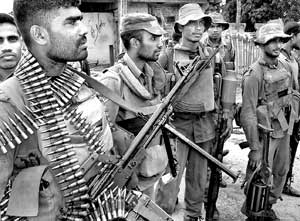As Government troops entered the final phase of their offensive against the LTTE in the Mullaitivu district, some of their key weapons meant to be used in the fighting against the security forces were discovered.
One of the vital discoveries was the presence of ‘undersea craft’ of the LTTE which were in the process of being manufactured and similar craft found near Puthukkudiyiruppu.
Troops from Task Force 3 involved in a search operation south-west of Puthukkudiyiruppu stumbled on an LTTE boatyard and were startled to discover four mini-submarines there.
 |
 |
| Soldiers in Mullaitivu town after its re-capture |
The largest underwater craft discovered by troops was about 35 feet in length and fitted with armour plates while the other three appeared to have been in the process of being built.
A senior Sri Lanka Navy officer told The Sunday Times that these submarines were in the experimental stage with no evidence of them being used by the LTTE for any operations. He said that if the submarines were fully developed the LTTE would have used them against the Sri Lanka Navy.
In 2006, an LTTE operative was arrested by the US Coast Guard along with a small submarine while transporting 7000 pounds of cocaine. Four men, including the Sri Lankan linked to the LTTE were arrested for trying to smuggle cocaine in a semi-submersible domestically made submarine. A U.S. Coast Guard cutter spotted them in their semi-submersible boat off the coast of Costa Rica.
A few years ago Thai authorities discovered a specially made semi-submersible submarine which was used by LTTE operatives to smuggle arms and ammunition. The submarine which was discovered in a coastal village located south of Thailand is said to be able to carry 10 tons of equipment.
Meanwhile, the Sri Lanka Navy has set up four barriers blocking the north-eastern coast of the island to prevent LTTE arms supplies coming and LTTE cadres escaping via sea. The Rapid Action Boat Squadron (RABS) and the Special Boat Squadron (SBS) units maintain their blockade closest to the coast while Fast Attack Flotilla 4 (FAF4) maintained the second barrier in the coastal waters. The third and fourth barriers are maintained by the gunboats and Offshore Patrol Vessels that extend from territorial waters to the blue waters.
On Friday, the Navy destroyed an LTTE suicide boat off the coast of Mullaitivu. The Navy has been kept on high alert on the Eastern coast to prevent the rebels from smuggling in arms and to prevent cadres from escaping.
Troops have gained control over a 10 km stretch of the road, running north of Vishvamadu via Puliyampokkanai towards Chundikkulam. Troops are also engaged in mopping up the remaining LTTE pockets south of Vishvamadu and Piramanthalkulam.
The fall of Vishvamadu comes following the security forces’ recapture of Mullaitivu town which had been dominated by the LTTE for the past 13 years.
Last Wednesday afternoon troops attached to the 58 Division under the command of Brigadier Shavendra Silva and troops of the 574 and 572 Brigades under the command of Major General Jagath Dias began to move forward towards the Vishvamadu junction in Mullaitivu district considered one of the major LTTE strongholds until it came under Government control.
On January 25 (Sunday), the 59 Division led by Brigadier Nandana Udawatte captured the rebel town after a year long operation. During the mopping up operations troops found a massive torture complex and more than 3000 photos of LTTE fighters who were killed during the recent fighting with the military.
They also found a damaged bullet-proof vehicle that would have been used by either Prabhakaran or other senior Tiger leaders. The rugged-looking covered pick up wagon, fitted with double steel sheets to make it bullet-proof, was found in the thick jungles of Mullaitivu.
Last Saturday the LTTE blasted the Kalmadukulam also known as the Komalamadukulam tank bund which was situated south of Vishvamadu resulting in the entire Vishvamadu and Tharmapuram areas being flooded.
It is learnt that hundreds of troops operating in Vishvamadu north and south climbed trees or fled to high ground to escape the sudden gush of water. A large number of cattle and many civilian properties were washed away in the rushing waters.
The LTTE’s intentions of capturing stranded soldiers and their ammunition stocks had not succeeded as troops managed to re-organize and counter the rebels.
It is believed that capturing areas such as Vishvamadu and Puthukkudiyiruppu by Government troops will deprive the LTTE from using all military hardware the rebels had shifted from Mannar towards areas such as these.
Vishvamadu is considered a secret locality which the senior LTTE leaders used. Most of their military bases and underground facilities and hideouts had been located in this area. The area is believed to have been frequently used by Prabhakaran as well. |


